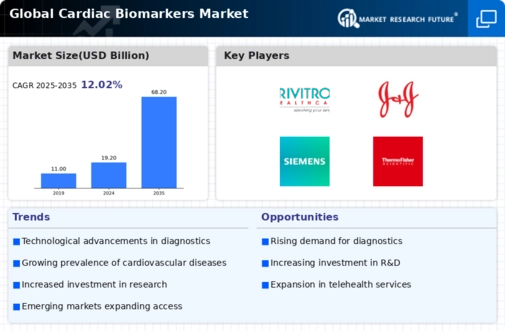Market Growth Projections
The Global Global Cardiac Biomarkers Market Industry is poised for substantial growth, with projections indicating a market value of 19.2 USD Billion in 2024 and a remarkable increase to 68.2 USD Billion by 2035. This growth trajectory suggests a compound annual growth rate (CAGR) of 12.21% from 2025 to 2035. Such figures reflect the increasing demand for cardiac biomarkers driven by the rising prevalence of cardiovascular diseases and advancements in diagnostic technologies. The market's expansion is likely to be supported by ongoing research efforts and the development of innovative biomarker solutions.
Regulatory Support for Biomarker Development
Regulatory bodies worldwide are increasingly supporting the development and approval of cardiac biomarkers, which is a significant driver for the Global Global Cardiac Biomarkers Market Industry. Streamlined regulatory pathways and guidelines facilitate the introduction of innovative biomarker tests into the market. This supportive environment encourages research and development efforts, enabling companies to bring new products to market more efficiently. As regulatory frameworks evolve to accommodate advancements in biomarker technology, the market is expected to benefit from an influx of novel diagnostic solutions, enhancing overall patient care.
Rising Prevalence of Cardiovascular Diseases
The increasing incidence of cardiovascular diseases globally drives the Global Global Cardiac Biomarkers Market Industry. According to health statistics, cardiovascular diseases remain a leading cause of mortality, accounting for approximately 31% of all deaths worldwide. This alarming trend necessitates the development and adoption of cardiac biomarkers for early diagnosis and management. As healthcare systems prioritize preventive measures, the demand for reliable biomarkers is expected to surge. In 2024, the market is projected to reach 19.2 USD Billion, reflecting the urgent need for innovative diagnostic tools that can enhance patient outcomes and reduce healthcare costs.
Growing Awareness and Education on Heart Health
Rising awareness regarding heart health among the global population plays a pivotal role in shaping the Global Global Cardiac Biomarkers Market Industry. Educational campaigns and initiatives by health organizations aim to inform individuals about the risks associated with cardiovascular diseases and the importance of early detection. This heightened awareness encourages individuals to seek preventive screenings and diagnostic tests, leading to increased utilization of cardiac biomarkers. Consequently, healthcare providers are likely to expand their offerings of biomarker tests, aligning with the growing demand for proactive health management strategies.
Increased Investment in Healthcare Infrastructure
The expansion of healthcare infrastructure globally is a critical driver for the Global Global Cardiac Biomarkers Market Industry. Governments and private sectors are investing heavily in healthcare facilities, particularly in emerging economies, to enhance access to diagnostic services. This investment includes the establishment of specialized cardiac care units and laboratories equipped with advanced diagnostic technologies. Such improvements are expected to facilitate the widespread adoption of cardiac biomarkers, thereby improving patient care. As healthcare systems evolve, the demand for innovative diagnostic solutions is anticipated to grow, further propelling the market forward.
Technological Advancements in Biomarker Discovery
Technological innovations in biomarker discovery and analysis significantly contribute to the growth of the Global Global Cardiac Biomarkers Market Industry. Advances in genomics, proteomics, and metabolomics facilitate the identification of novel cardiac biomarkers, enhancing diagnostic accuracy. For instance, the integration of artificial intelligence and machine learning in data analysis allows for more efficient processing of complex biological data. These advancements not only improve the sensitivity and specificity of tests but also streamline the development of point-of-care testing solutions. As a result, the market is likely to experience substantial growth, with projections indicating a rise to 68.2 USD Billion by 2035.















